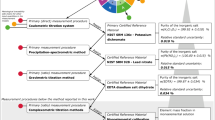Summary
Kinetics of formation of [PdCl4]2− from [Pd(ox)2]2− and [Pd(mal)2]2− has been studies in aqueous acid media in the presence of an excess of chloride ion by stopped-flow spectrophotometry. Both the complexes undergo the transformation in two well separated consecutive steps. In 0.02–0.05 M acid with 0.2 M Cl−, Pd(AA)2− dissociates leading to the formation of [Pd(AA)Cl2]2− (where AA =ox2− or mal2−), which in 0.1–0.6 M acid and 1 M Cl− forms [PdCl4]2− in a relatively slow step. For both steps kabs=k0+k2[H+][Cl−]. Activation parameters corresponding to k0 and k2 have been determined. Results indicate that [Pd(mal)2]2− is much more labile to substitution than [Pd(ox)2]2− and for both the lability is far greater than that of [Pd(bigH)2]2+ and [Pt(ox)2]2− reported earlier.
Similar content being viewed by others
References
R. G. Pearson and D. A. Johson,J. Am. Chem. Soc.,86, 3983 (1964).
A. J. Pöe and H. D. Vaughan,Inorg. Chim. Acta,1, 225 (1967).
J. C. Copper, L. L. Wong and D. W. Mergerum,Inorg. Chem. 17, 261 (1978).
J. S. Coe and J. R. Lyons,J. Chem. Soc A, 829 (1971).
D. Banerjea and P. Banerjee,Z. Anorg. Allgm. Chem.,393, 295 (1972).
M. Casumano, G. Guglielmo, V. Ricevuto, R. Romeo and M. Trozzi,Inorg. Chim. Acta,16, 135 (1976).
M. Casumano, G. Guglielmo, V. Ricevuto, R. Romeo and M. Trozzi,Atti. Soc. Peloritana Sci. fis. mat. nat.,45, 89 (1974) (Chem. Abstr.,85, 25788 (1976).
S. Matsumoto and S. Kawaguchi,Bull. Chem. Soc. Japan,53, 1577 (1980).
S. Balt, J. Meuldijk and A. A. Wismeijer,Transition Met. Chem.,6, 267 (1981).
D. Banerjea and P. Banerjee,Z. Anorg. Allgm. Chem.,401, 189 (1973).
D. Banerjea and K. K. Tripathi,J. Inorg. Nucl. Chem.,7, 78 (1958).
D. Banerjea and S. Dutta Chaudhuri,J. Inorg. Nucl. Chem.,32, 2985 (1970).
A. V. Babaeva and M. A. Mosygine,Dokl. Acad. Nauk. SSSR,64, 825 (1949).
M. J. Schmelz, I. Nakagawa, S. Mizushima and J. V. Quagliano,J. Am. Chem. Soc. 81, 287 (1959).
C. K. Jorgensen inAbsorption Spectra and Chemical Bonding in Complexes, p. 287, 2nd revised impr., Pergamon Press, London, 1964.
Author information
Authors and Affiliations
Rights and permissions
About this article
Cite this article
Das, A.K., Gangopadhyay, S. & Banerjea, D. Kinetics and mechanism of formation of tetrachloropalladate(II) in the reactions of bis(oxalato)- and bis(malonato) palladate(II) with chloride in acid media. Transition Met Chem 14, 73–75 (1989). https://doi.org/10.1007/BF01129765
Received:
Issue Date:
DOI: https://doi.org/10.1007/BF01129765




